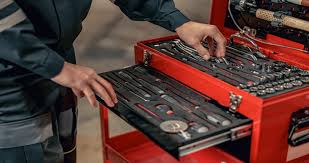The hangar floor hums with activity – technicians meticulously inspect and repair the complex machinery that keeps our skies safe. At the heart of their expertise lies a crucial companion: the aircraft tech tool kit. Far from a mere collection of wrenches and screwdrivers, these kits are meticulously curated arsenals designed for precision and efficiency.
This guide delves into the essential tools that form the backbone of an aircraft technician’s kit, along with specialized options for specific tasks. We’ll also explore the factors to consider when selecting the perfect kit and proper tool care techniques to ensure longevity and performance.
Core Equipment for Aircraft Repair
While the specific contents of a kit may vary depending on the type of aircraft and maintenance tasks, some fundamental tools are universally essential:
- Screwdrivers (Flat-head and Phillips): The workhorses for removing and installing screws in various aircraft components.
- Wrenches (Open-end, Box-end, Adjustable): Indispensable for tightening and loosening nuts and bolts of varying shapes and sizes.
- Sockets and Ratchets: Offering flexibility and efficiency, socket sets with diverse sizes and lengths, coupled with ratchets, become invaluable for navigating tight spaces.
- Pliers (Needle-nose, Wire Cutters, Combination): Versatile tools for gripping, cutting, and bending wires and small parts with precision.
- Hammers (Rubber Mallet and Metal): Used for striking and shaping components without causing damage, ensuring controlled application of force.
- Torque Wrenches: Crucial for ensuring bolts and nuts are tightened to precise specifications, guaranteeing aircraft safety.
- Aviation Snips: Designed specifically for cutting aircraft materials like aluminum and steel, ensuring clean and precise cuts.
- Drill and Bits: Electric drills with a variety of drill bits allow for drilling holes of various sizes in aircraft components.
- Measuring Tools (Calipers, Micrometers, Rulers): Essential for ensuring precise measurements and adhering to critical tolerances.
- Safety Tools (Safety Glasses, Ear Protection, Gloves): Protecting technicians from potential hazards during maintenance tasks is paramount.
Specialty Tools for Aircraft Maintenance
Beyond the core tools, aircraft tech kits often include specialized equipment for specific jobs:
- Riveting Tools (Rivet Guns and Bucking Bars): Used for installing rivets in aircraft structures, ensuring structural integrity.
- Hydraulic Tools (Hydraulic Presses and Crimping Tools): Crucial for working on hydraulic systems, vital for aircraft operation.
- Electrical Tools (Multimeters, Wire Strippers, Soldering Irons): Used for diagnosing and repairing electrical systems with accuracy.
- Engine Tools (Valve Spring Compressors and Piston Ring Removers): Specialized tools required for specific engine maintenance tasks.
Factors to Consider When Choosing an Aircraft Tech Tool Kit
Selecting the right aircraft tech tool kit involves a thoughtful process:
- Aircraft Type: The type of aircraft you work on will determine the specific tools you need. A small private plane kit differs from one for a large commercial airliner.
- Maintenance Tasks: The types of maintenance tasks you perform influence the tools required. An engine overhaul mechanic needs different tools than an avionics technician.
- Budget: Tool kit costs can vary significantly based on the number and quality of tools. Prioritize essential tools and work within your budget.
- Brand and Reputation: Choose a reputable brand known for high-quality tools designed to withstand the rigors of aircraft maintenance.
- Storage and Organization: Consider the kit’s size and storage options. A well-organized kit saves time and prevents lost or misplaced tools.
Proper Tool Care and Maintenance
Extending the life and effectiveness of your aircraft tech tool kit involves proper care and maintenance:
- Clean Tools Regularly: Remove dirt, debris, and corrosive materials after each use to prevent damage and ensure optimal performance.
- Lubricate Moving Parts: Apply lubricant to moving parts like wrenches and pliers to reduce friction and wear.
- Store Tools Properly: Secure and organized storage prevents loss or damage. Use a tool chest or dedicated storage area.
- Inspect for Damage: Regularly inspect tools for signs of wear or damage. Replace faulty tools promptly to avoid accidents and ensure accurate work.
Conclusion
An aircraft tech tool kit is not just a collection of tools; it’s an embodiment of a technician’s expertise. Understanding the essential tools and factors to consider when selecting a kit empowers you with the right equipment to perform safe and efficient aircraft maintenance and repairs. A well-maintained and well-equipped tool kit is a testament to a technician’s professionalism and dedication to aviation safety.




